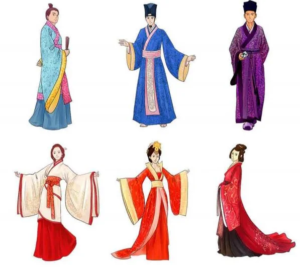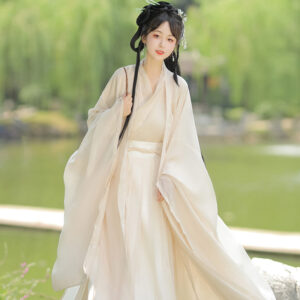
Choosing the right Hanfu for different seasons involves selecting appropriate fabrics, styles, and layers to suit the weather, while also maintaining the traditional elegance of this ancient Chinese attire. Just like modern clothing, the design of Hanfu changes depending on the season, balancing aesthetics with comfort. Here’s how to pick the perfect Hanfu for each season:
1. Spring (春) Hanfu: Light and Layered
Spring is a time of renewal, with mild temperatures and blooming flowers. The Hanfu styles for this season reflect the balance of warmth and freshness.
- Fabrics: In spring, it’s best to choose Hanfu made from light, breathable materials such as silk or thin cotton. Silk is particularly ideal because it drapes beautifully and keeps the body cool, but it also retains enough warmth for the cooler early spring days.
- Styles: Layering is key during spring. A common combination includes a Ruqun (a blouse and skirt combination) paired with a Pifeng (披风, a cloak or cape) or Beizi (褙子, a long, loose outer jacket). These layers can easily be added or removed as temperatures fluctuate.
- Colors and Patterns: Pastel colors like light green, pink, soft blues, and pale yellows are popular choices, reflecting the season’s blossoms. Patterns of flowers, butterflies, and birds are common, symbolizing growth and new beginnings.
2. Summer (夏) Hanfu: Lightweight and Breathable
Summer in many parts of China can be hot and humid, so the choice of Hanfu needs to prioritize breathability and lightness.
- Fabrics: Linen, cotton, and gauze (a very light, transparent fabric) are ideal choices for summer Hanfu. These materials allow air to circulate and help keep the body cool in the heat. Silk gauze (纱, sha) is also a popular option, offering a more luxurious but equally breathable alternative.
- Styles: Hanfu styles for summer are usually simpler and more minimal, with fewer layers. The Shenyi (深衣, a long, flowing robe) or a short-sleeved Ruqun are popular summer choices. Some summer Hanfu designs feature open sleeves or looser fits to allow for more air circulation.
- Colors and Patterns: Cool tones like white, light blue, soft lavender, and light grey are often used in summer to reflect heat. Floral motifs such as lotus flowers and bamboo, which have cultural significance for their associations with purity and resilience, are common in summer Hanfu.
3. Autumn (秋) Hanfu: Warm and Earthy
Autumn brings cooler weather, so Hanfu choices during this season aim to balance warmth with the traditional elegance of fall’s natural beauty.
- Fabrics: Autumn Hanfu often uses slightly heavier fabrics, such as cotton, thick silk, and light wool. These materials provide warmth but are not too heavy, as autumn temperatures tend to vary.
- Styles: Layering returns in autumn, with Beizi or Pifeng worn over Qixiong Ruqun (齐胸襦裙, high-waisted skirt) or a more fitted, long-sleeved Shan (shirt) and Qun (skirt) ensemble. Long, wide-sleeved robes are popular, offering both warmth and aesthetic appeal.
- Colors and Patterns: Deep, rich colors like burgundy, mustard yellow, burnt orange, and browns are often chosen to reflect the autumn foliage. Embroidered patterns of falling leaves, chrysanthemums, or geese are common, symbolizing the harvest season and the coming of winter.
4. Winter (冬) Hanfu: Thick and Cozy
Winter requires warmth, and Hanfu for this season is designed to protect against the cold while still showcasing traditional Chinese styles.
- Fabrics: Winter Hanfu is often made from wool, cotton-lined silk, or thick brocade. Fur-lined garments, especially for those in colder northern regions of China, were historically common and remain popular in modern winter Hanfu designs.
- Styles: The key to winter Hanfu is layering and the use of thicker outer garments. The Changshan (长衫, a long robe) or Aoqun (袄裙, a thick, quilted jacket and skirt set) are common winter styles. In very cold conditions, a Daxiushan (大袖衫, large-sleeved outer robe) or Qiu Yi (fur-lined winter coat) is often worn on top. Cloaks or capes with fur trim are popular for both warmth and style.
- Colors and Patterns: Dark, rich tones like navy blue, dark green, maroon, and black are common in winter, reflecting the more subdued nature of the season. Embroidered designs often include symbols of longevity and prosperity, such as cranes or pine trees, and winter elements like snowflakes or plum blossoms, which bloom in the cold.
5. Accessories and Seasonal Adaptations
Accessories also play an important role in adjusting Hanfu for different seasons. For example:
- Fans: In summer, delicate silk fans or bamboo folding fans are carried to help stay cool.
- Scarves and Cloaks: In winter, silk or fur-lined scarves, along with thick cloaks, add extra warmth.
- Shoes: Lightweight, flat-soled shoes are worn in spring and summer, while more insulated, lined shoes are preferred in winter.
Conclusion: Seasonal Elegance in Hanfu
Choosing the right Hanfu for each season involves balancing comfort with the timeless elegance of this traditional attire. The key is selecting appropriate fabrics and styles that suit the weather while reflecting the beauty of each season. Whether it’s the light and airy fabrics of summer or the layered warmth of winter, Hanfu continues to adapt beautifully to seasonal changes, allowing for both practicality and grace.
Share this post
Recent Posts


What were the key features of Hanfu during the Tang Dynasty?

How did Hanfu styles vary during different Chinese dynasties?

What accessories are typically worn with Hanfu?

How do you choose the right Hanfu for different seasons?

Newsletter
Popular Categories
Related Post
Sed aliquam, tortor et sodales malesuada, lorem leo luctus tellus, quis interdum eros nibh in nunc. Cras dignissim malesuada, lorem leo luctus

What are the winter hanfu called?

What were the key features of Hanfu during the Tang Dynasty?

How did Hanfu styles vary during different Chinese dynasties?


